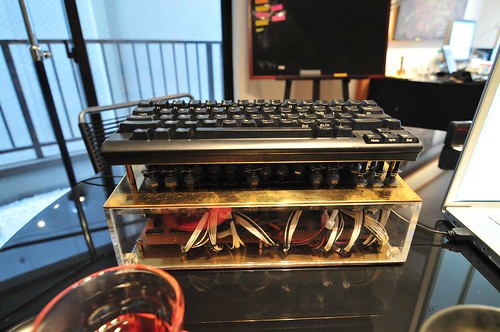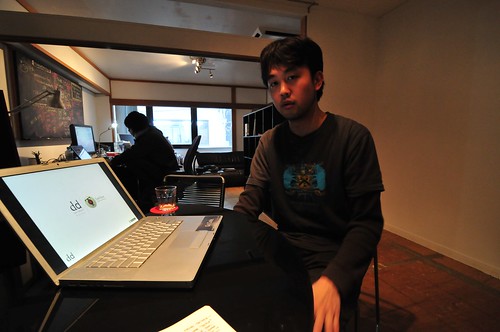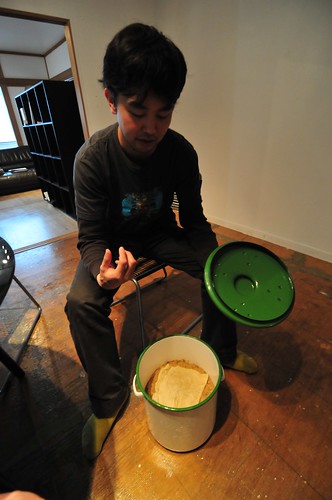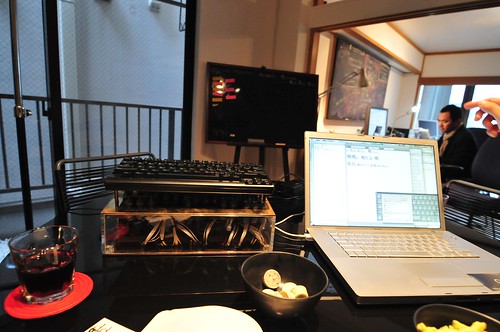Spent a very cool conversational show-and-tell-y bit of time with dividual’s Dominick Chen and Takumi Endo at their new cozy studio digs. I guess Paul connected us last minute, which is basically how this whole trip has been, which is fine.
Dominick and Takumi have been working quite a bit with the semantics of time in digital interactions. They created this project called TypeTrace. It’s a mechanism for exploring the relationship between physical interactions in digital contexts. A keyboard is used to record the composition of words — letters or books, in one case. The recording captures all subtleties of working at a keyboard, which can then be played back with the keyboard acting as a kind of player piano. The keys are literally articulated from underneath, giving the appearance of a ghost writing the composition. If a key is held done a bit longer than others, you see that (and hear it.) The letters and words are played back on screen, changing their typography depending on how long the composer has lingered over certain passages. Letters and words will grow in size if a key is held down a bit longer than others, suggesting that the composer has lingered over a word, and insinuating, perhaps, that their thoughts mulled over the meaning at that point of the composition.
Our conversation about “slow” things and the meaning of time in a digital age, compelled Dominick to slip into the studio kitchen and bring out their fermentation vat — another slow process. In the digitally networked milieu, fermentation gets a creative commons mark!
Chen studied at UCLA’s DMA. The TypeTrace project started out as an interactive art project, exhibiting in various museum and gallery contexts. It had some good success. Chen went on to begin studies in an interdisciplinary Ph.D. program in Tokyo, and left that recently to pursue TypeTrace. His interest, shared I believe by many smart, aspirational autodidactic thinker/maker/researcher/theory people is to find ways to circulate his ideas outside of the usual art contexts, and beyond the confines of academia, where “makers” are relegated to engineering disciplines. Like many others, he finds the “interdisciplinary” approach to art-technology-design works best in cocktail party conversations than it does when academia tries it in actual practice.
While we were talking, we found a common interest in the possibilities of working from the fringes of design, art and technology — doing peculiar things that are partly based on artistic dreams, the practical and instrumental aspects of engineering, and design principles that put the experiences of people front and center. I shared with him the work I’ve been doing on the Slow Messenger and Slow Mail projects — similar principles in many respects to TypeTrace. (The idea that something is lost in the lickity-split “conversations” of digital messaging.) We talked about the relationships between design, art and technology. Or, I tried to explain (the reason I am in Tokyo) that I am trying to understand more completely this question I am having about ways to create new experiences when design, art and technology are brought together. (I’m coming to a conclusion that interdisciplinarity is a dead, especially as I see more and more practitioners who embody, simultaneously, these “practices” and are quite undisciplinary in that they have no professional stakes in a conventional sense, to any of art, design or engineering. More about this later.)





In ‘The New Production of Knowledge’ Michael Gibbons and his co-authors introduced the notion of mode 2 research, which is newly emerging, context-driven, problem-focused and interdisciplinary knowledge production. This he and his colleagues distinguished from traditional mode 1 research, which is academic, investigator-initiated and discipline-based (Gibbons et al, 1994). They identify a fundamental change in the ways that scientific, social, and cultural knowledge are being produced. The basic qualities of this new production of knowledge are: complexity, hybridity, non-linearity, reflexivity, heterogeneity, and transdisciplinarity. This hybridisation reflects the need to accomplish tasks at the boundaries and in the spaces between different communities (Gibbons, et al 1994, p.37). These enable collaboration, integrative problem solving, and development of new hybrid fields. ‘Mode 1’ is concerned with first principles in which questions and problems are dealt with in a context governed by the largely academic interests of a specific community of practice (CoP). ‘Mode 2’ research is based on a context of application in response to the demand for solutions to problems from a community of interest (CoI). The first mode of research is primarily disciplinary in nature whereas the second is characterised as being transdisciplinary in nature. An objective of my PhD research project was to establish if a trend towards a hybrid model of art & design practice is emerging out of the use of computer-based tools and if so, what implications this might have for future practice. The research has shown a considerable shift in the thinking of practitioners that make use of computer-based design and fabrication technologies. All of the practitioners I interviewed pointed out that their practice had been transformed by the use of computer-based tools. In addition, a third of them stated that the nature of their practice was now defined by the use of these technologies and indicated that use of these technologies had changed how they think about or see the world. For me, this indicates the possibility of a form of ‘technology-led-practice’. I think this can apply equally to disciplinary-based, transdisciplinary or (speculatively) post-disciplinary modes of practice. Michel Foucault (1977, p.113-138) discussed the idea of a ‘transdiscursive position’ – those who are initiators of new discursive practices, not just of individual texts. These all sit happily under your ‘undisciplinary’ umbrella.